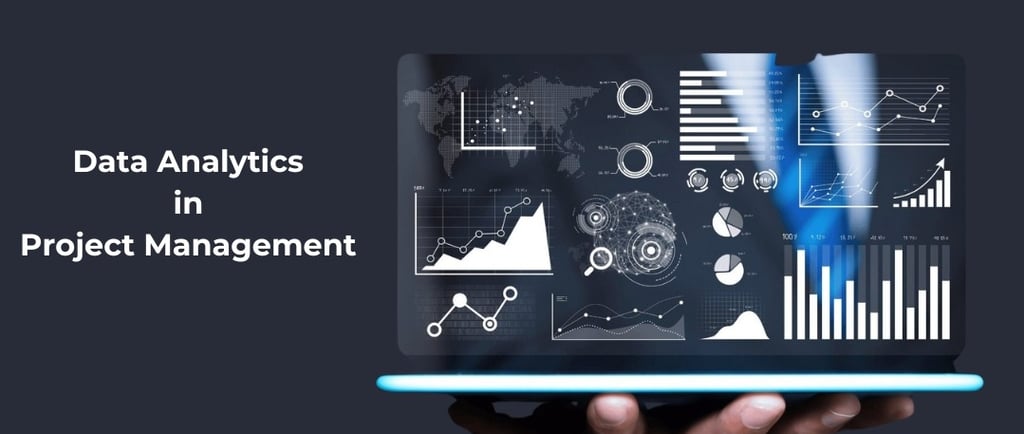Leveraging Data Analytics for Better Project Management Decisions
Unlock the potential of data analytics to revolutionize your project management practices. This comprehensive guide delves into how small to medium-sized businesses can harness the power of data to enhance decision-making, optimize resource allocation, and identify potential risks. Explore practical steps for implementing data analytics, including defining objectives, data collection, processing, and visualization. Learn from real-world case studies and discover future trends like AI and real-time analytics that will shape the future of project management. Transform your projects and drive success with data-driven insights.
BLOG
7/10/20243 min read


Introduction
In today’s data-driven world, the ability to leverage data analytics effectively can significantly enhance project management processes. For small to medium-sized businesses (SMBs), this capability can be a game-changer, enabling better decision-making, resource allocation, and risk management. This comprehensive guide explores how data analytics can be utilized to improve project management decisions, ensuring that projects are completed on time, within budget, and to the desired quality standards.
The Role of Data Analytics in Project Management
Data analytics involves the systematic computational analysis of data, which can be utilized to discover patterns, correlations, and trends. In the context of project management, data analytics can be used to:
Track Project Progress: By analyzing project data, managers can monitor progress against milestones and timelines.
Identify Risks: Data analytics can help in predicting potential risks and issues before they become critical.
Optimize Resources: By understanding resource utilization, project managers can allocate resources more effectively.
Enhance Decision-Making: Data-driven insights enable more informed and objective decision-making.
Improve Stakeholder Communication: Data visualization tools can help in presenting complex data in an easily understandable format for stakeholders.
Key Data Analytics Techniques in Project Management
Descriptive Analytics: This involves summarizing historical data to understand what has happened in past projects. Techniques include data aggregation, mining, and visualization.
Predictive Analytics: This involves using statistical models and machine learning algorithms to predict future project outcomes based on historical data.
Prescriptive Analytics: This provides recommendations for decision-making based on predictive analytics and optimization algorithms.
Implementing Data Analytics in SMB Project Management
Step 1: Define Objectives and KPIs
Before implementing data analytics, it’s crucial to define clear objectives and key performance indicators (KPIs). These will guide the data collection and analysis processes. Common project management KPIs include:
Project completion time
Budget variance
Resource utilization
Risk occurrence
Step 2: Data Collection
Collecting accurate and relevant data is the foundation of effective data analytics. SMBs can gather data from various sources such as project management software, financial systems, and team collaboration tools. Key data points include:
Time tracking data
Budget and cost data
Resource allocation and usage
Task completion data
Step 3: Data Processing and Cleaning
Raw data often contains errors and inconsistencies. Data cleaning involves correcting or removing inaccurate records from the dataset. This step ensures the accuracy and reliability of the data used for analysis.
Step 4: Data Analysis
Once the data is clean, various analytical techniques can be applied. For SMBs, tools like Excel, Tableau, and Power BI can be very effective for data analysis and visualization. Key analysis methods include:
Trend Analysis: Identifying patterns over time.
Variance Analysis: Comparing planned versus actual performance.
Correlation Analysis: Identifying relationships between different variables.
Step 5: Data Visualization
Presenting data in a visual format can help stakeholders quickly understand insights. Tools like Gantt charts, dashboards, and heatmaps can be very effective. Data visualization should focus on key metrics and trends relevant to project performance.
Case Studies
Case Study 1: Improving Project Timeliness
Company: A medium-sized marketing agency
Challenge: The agency faced frequent delays in project completion.
Solution: The agency implemented data analytics to track time spent on various tasks and identified bottlenecks in the process.
Outcome: By addressing the bottlenecks, the agency reduced project completion time by 20%.
Case Study 2: Optimizing Resource Allocation
Company: A small software development firm
Challenge: Inefficient resource allocation leading to budget overruns.
Solution: The firm used data analytics to analyze resource utilization and realigned resource allocation based on project needs.
Outcome: The firm achieved a 15% reduction in project costs and improved resource utilization by 30%.
Challenges and Solutions
Data Quality: Poor data quality can lead to inaccurate insights. Implementing robust data collection and cleaning processes is crucial.
Data Integration: Integrating data from multiple sources can be challenging. Using integrated project management tools can help streamline this process.
Skills Gap: SMBs may lack the necessary skills for data analytics. Investing in training or partnering with data analytics experts can bridge this gap.
Future Trends in Data Analytics for Project Management
Artificial Intelligence: AI-driven analytics can provide more advanced predictive and prescriptive insights.
Real-Time Analytics: The ability to analyze data in real-time will enable more agile and responsive project management.
Integration with IoT: IoT devices can provide real-time data, enhancing monitoring and decision-making processes.
Conclusion
Leveraging data analytics can significantly enhance project management processes for SMBs, leading to better decision-making, resource optimization, and risk management. By defining clear objectives, collecting accurate data, and using the right analytical techniques and tools, SMBs can transform their project management practices and achieve greater success. As technology continues to evolve, the integration of AI and real-time analytics will further enhance the capabilities of data-driven project management.
© 2025. All rights reserved.

